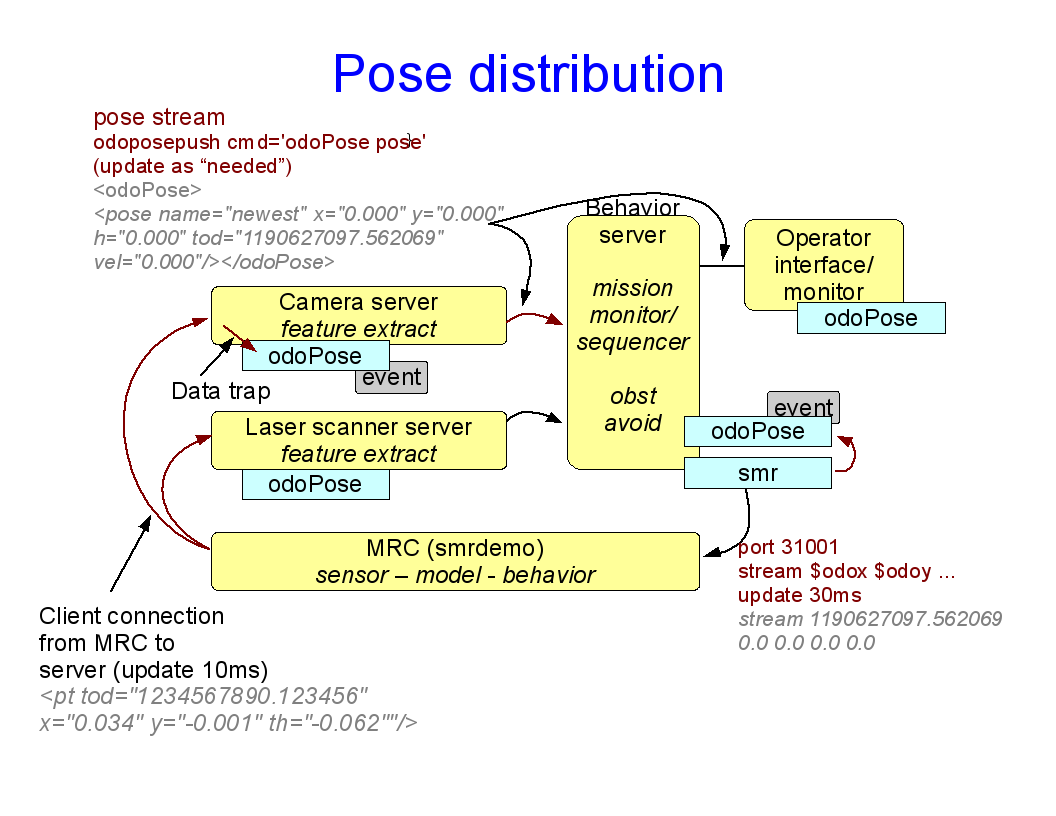Pose
Three static modules are available to maintain and service coordinate systems:
- odoPose intended for odometry pose as maintained from MRC (smrdemo)
- mapPose intended for a map coordinate system, e.g. oriented as a room, building or area coordinate reference
- utmPose intended to be maintained from a GPS and possibly backed by localization from known map positions in UTM coordinates.
To add a module see (e.g. from the server window or in a script)
module help
To add all three coordinate system modules:
module add=mappose module add=odoPose module add=utmPose
Main function of pose information
The pose is information of robot position in som coordinate system at a point in time. The module stores a number of updates (currently 2000) and holds functions to maintain, query and do some calculations on this stack of positions. Update of the pose can trigger an event, that can be used to trigger some action, e.g. a sensor fusion update or transfer of pose to another server.
A few parameters determine if an update is stored as an update, determined on the movement and the time since last stored update. Default values are (if not changed):
minDist = 0.03 // Adding update to history if distance is more than this minTurn = 1.0 * M_PI / 180.0 // Adding update to history if turned more than this (1 degree) minTime = 10.0 // Adding update to history if time passed is more than this
If either of these limitations are exceeded, then the new update is added to the update buffer. This means that if the distance criteria is the limiting criteria, then there could be 2000*0.03 = 60m of valid poses in the history buffer.
The history buffer can be used to determine
* pose at a specific time (often used to determine pose at the time of some sensor data.) * pose at a distance from current position - e.g. 5m from current position, calculated as direct distance, not traveled distance. * Direct iteration into stored values.
These functions are usually used directly using C++ calls to this resource.
A number of global available values are maintained, such as the distance traveled. These are primarily intended to be used by a mission scheduler, as trip counter and time passed functions. See e.g.:
var mapPose
to get an overview of available global values available.
How to use (one of) the pose modules from your own plug-in
You can get access to the pose module using a resource pointer. The procedure is the same if you need it in an interface part of the plug-in or in a resource.
Create a pointer in the class definition to the common type UResPoseHist, e.g.:
#include <urob4/uresposehist.h> ... protected: UResPoseHist * mapPose;
This mapPose pointer needs to be initialized to NULL in the class constructor, as this usually is used as an indication of an invalid resource. e.g.:
UResYourClass::UResYourClass()
{
setResID(getResID());
resVersion = getResVersion();
mapPose = NULL;
}
The server core will tell you about available resources - and changes in the resource situation, this is done with a call to the function setResource(UResBase * resource, bool remove), and if your program should listen to this call, to get the correct pointer, i.e. to get the mapPose pointer:
bool UResYourClass::setResource(UResBase * resource, bool remove)
{
bool result = true;
if (resource->isA(UResPoseHist::getMapPoseID())) // *note
{ // ressource may be deleted or change
if (remove)
mapPose = NULL;
else if (mapPose != resource)
mapPose = (UResPoseHist *)resource;
else
result = false; // the resource is not neded by this class
}
// the base class may need the resource
result &= UResVarPool::setResource(resource, remove);
return result; // used or not
}
- note: The other alternatives are: UResPoseHist::getOdoPoseID() and UResPoseHist::getUtmPoseID() for the other coordinate systems.
Now the resource pointer is in place, ready for use.
Update with new positions
The main assumption is that one plugin maintains the pose and one or more other plugins (or the mission sequencer) uses the information.
To update the mapPose plugin, just provide a pose and the time when the pose is valid
UPoseTime pt; // structure with x, y, h and time UTime t; // just time in linux time format (seconds since 1 jan 1970) // t.now(); // set time from linux clock pt.set(xPosition, yPosition, headingInRadians); // set some pose pt.t = t; // add the time mapPose->addIfNeeded(pt, 0.0, -12); // add the new pose (if needed)
The call to addIfNeeded(...) has three parameters, the first is the pose, the second is an optional speed (not essential), the last is a number used to identify the updater - negative numbers are an update from a plugin, a positive number is a TCP/IP client. This number is available to ease debugging in the help text:
mapPose help
Use the resource pointer to get a pose
To get a pose will normally use getPoseAtTime(UTime atTime), like:
UPose pose; UTime t; // t.now(); pose = mapPose->getPoseAtTime(t);
See the class documentation for UResPoseHist for other available methods and values.
